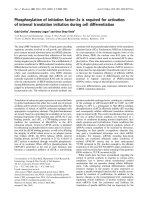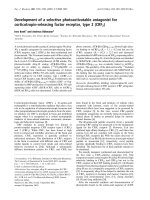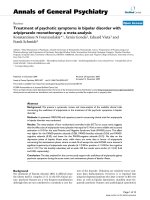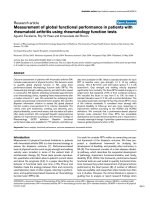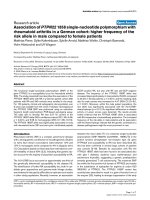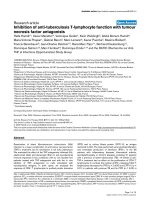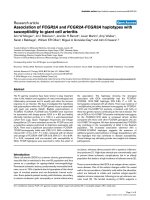Báo cáo y học: "Development of bone marrow lesions is associated with adverse effects on knee cartilage while resolution is associated with improvement - a potential target for prevention of knee osteoarthritis: a longitudinal study" pdf
Bạn đang xem bản rút gọn của tài liệu. Xem và tải ngay bản đầy đủ của tài liệu tại đây (970.37 KB, 8 trang )
Davies-Tuck et al. Arthritis Research & Therapy 2010, 12:R10
/>Open Access
RESEARCH ARTICLE
© 2010 Davies-Tuck et al.; licensee BioMed Central Ltd. This is an open access article distributed under the terms of the Creative Com-
mons Attribution License ( which permits unrestricted use, distribution, and reproduc-
tion in any medium, provided the original work is properly cited.
Research article
Development of bone marrow lesions is associated
with adverse effects on knee cartilage while
resolution is associated with improvement - a
potential target for prevention of knee
osteoarthritis: a longitudinal study
Miranda L Davies-Tuck
1
, Anita E Wluka
1,2
, Andrew Forbes
1
, Yuanyuan Wang
1
, Dallas R English
3,4
, Graham G Giles
3
,
Richard O'Sullivan
5
and Flavia M Cicuttini*
1
Abstract
Introduction: To examine the relationship between development or resolution of bone marrow lesions (BMLs) and
knee cartilage properties in a 2 year prospective study of asymptomatic middle-aged adults.
Methods: 271 adults recruited from the Melbourne Collaborative Cohort Study, underwent a magnetic resonance
imaging scan (MRI) of their dominant knee at baseline and again approximately 2 years later. Cartilage volume,
cartilage defects and BMLs were determined at both time points.
Results: Among 234 subjects free of BMLs at baseline, 33 developed BMLs over 2 years. The incidence of BMLs was
associated with progression of tibiofemoral cartilage defects (OR 2.63 (95% CI 0.93, 7.44), P = 0.07 for medial
compartment; OR 3.13 (95% CI 1.01, 9.68), P = 0.048 for lateral compartment). Among 37 subjects with BMLs at
baseline, 17 resolved. Resolution of BMLs was associated with reduced annual loss of medial tibial cartilage volume
(regression coefficient -35.9 (95%CI -65, -6.82), P = 0.02) and a trend for reduced progression of medial tibiofemoral
cartilage defects (OR 0.2 (95% CI 0.04, 1.09), P = 0.06).
Conclusions: In this cohort study of asymptomatic middle-aged adults the development of new BMLs was associated
with progressive knee cartilage pathology while resolution of BMLs prevalent at baseline was associated with reduced
progression of cartilage pathology. Further work examining the relationship between changes and BML and cartilage
may provide another important target for the prevention of knee osteoarthritis.
Introduction
There is increasing interest in the role of bone marrow
lesions (BMLs), detected by magnetic resonance imaging
(MRI), in the pathogenesis of knee osteoarthritis (OA)
[1,2]. Histological examination of BMLs in knees has
reported that they may represent areas of osteonecrosis,
oedema, trabecular abnormalities and bony remodeling [3].
BMLs are present in both symptomatic [4-7] and asymp-
tomatic populations [8,9]. Although BMLs are found to be
extremely common in OA populations and, once present,
are unlikely to resolve [7,10,11], in asymptomatic popula-
tions they tend to have a more fluctuating course [12].
BMLs have most commonly been described in relation to
mechanical factors such as trauma [13-16], knee malalign-
ment [17], and increased body weight [8]. However, more
recently systemic factors such as osteo-protective medica-
tions [18] and nutritional factors [19,20] have been reported
to affect the risk of BMLs.
Very little is known about the relation between BMLs and
other changes in knee structures in asymptomatic, clinically
healthy populations. Most previous studies have focussed
on symptomatic populations with established knee OA
* Correspondence:
1
Department of Epidemiology and Preventive Medicine, Monash University,
Central and Eastern Clinical School, Alfred Hospital, Melbourne, VIC 3004,
Australia
Davies-Tuck et al. Arthritis Research & Therapy 2010, 12:R10
/>Page 2 of 8
[6,10,11,21], where BMLs are associated with knee symp-
toms [4,21-25] and progression of structural changes
including joint space narrowing [17], loss of cartilage
[6,26] and increased prevalence and severity of cartilage
defects [23,27]. More recently in an asymptomatic popula-
tion, the presence of BMLs at baseline was shown to be
associated with longitudinal progression of cartilage defects
and loss of cartilage volume [28] suggesting that BMLs
also have a pathogenic role in pre-clinical OA.
The significance of development or resolution of preva-
lent BMLs has only recently been examined in populations
with, or at high risk of, knee OA [6,7,29]. In two of these
studies, the majority of BMLs persisted so both could only
examine the effect of change in size of the BMLs, had lim-
ited ability to examine incident BMLs, and had no power to
investigate resolution [6,7]. In contrast, for participants of
the Multi-centre Osteoarthritis Study (MOST) who either
had or were at high risk of OA, approximately 40% of
BMLs completely resolved and about one-third of cartilage
locations developed new BMLs over 30 months, but no sig-
nificant association between resolution of BMLs and
change in cartilage was seen. In addition, the presence, res-
olution and progression of the BMLs was observed simulta-
neously within the same knee suggesting that complete
resolution of all BMLs in a knee occurred less frequently.
Worsening of BMLs and development of new BMLs was
associated with increased cartilage loss compared with
where BMLs remained stable [29]; however, no compari-
son between knees with incident BMLs and knees that
remained free of BMLs was made. Recently, we have
shown for asymptomatic populations that BMLs fluctuate
with about 50% resolving and about 14% of people devel-
oping new ones over two years [12,30]. Thus, the aim of
this study was to examine the relation between incident
BMLs and the resolution of BMLs prevalent at baseline and
change in knee cartilage over two years in a cohort of
asymptomatic middle-aged adults.
Materials and methods
Participants
The study was conducted within the Melbourne Collabora-
tive Cohort Study, a prospective cohort study of 41,528
people, assembled to examine the role of lifestyle and
genetic factors in the risk of cancer and chronic diseases in
Melbourne, Australia [31]. Participants for the current
study were recruited from this cohort in 2003-04 if they
were aged between 50 and 79 years without any of the fol-
lowing exclusion criteria: a clinical diagnosis of knee OA
as defined by American College of Rheumatology criteria
[32]; knee pain lasting for more than 24 hours in the past
five years; a previous knee injury requiring non-weight
bearing treatment for more than 24 hours or surgery
(including arthroscopy); a history of any form of arthritis
diagnosed by a medical practitioner or a contraindication to
MRI, as previously described [33]. The study was approved
by The Cancer Council Victoria's Human Research Ethics
Committee and the Standing Committee on Ethics in
Research Involving Humans of Monash University, Mel-
bourne. All participants gave written informed consent.
Anthropometric data
Height (cm) was measured using a stadiometer with shoes
removed at baseline (1990-94). Weight (kg) was measured
with bulky clothing removed at the time of MRI. Body
mass index (BMI) was calculated from these data (weight
(kg)/height
2
(m
2
)).
MRI and the measurement of BMLs, cartilage volume and
defects
MRI
An MRI of the dominant knee (defined as the lower limb
from which the subject stepped off from when initiating
gait) for each participant was performed between October
2003 and December 2004 and approximately two years
later, as described on a 1.5-T whole body MR unit (Philips,
Medical Systems, Eindhoven, the Netherlands) using a
commercial transmit-receive extremity coil [9]. The follow-
ing sequences and parameters were used: fat suppressed,
gradient recall acquisition in the steady state, three dimen-
sional T1-weighted (58 msec/12 msec/55°, repetition time/
echo time/flip angle), one signal average, slice thickness
1.5 mm, field of view 16 cm and matrix 512 × 512 scans. In
addition, a coronal T2-weighted fat-saturated acquisition,
(3500 to 3800 msec/20/80 msec/90°, repetition time/echo
time/flip angle), two signal averages, echo train length of
10, with a slice thickness of 3.0 mm, a 1.0 inter slice gap, 1
excitation, a field of view of 13 cm, and a matrix of 256 ×
192 pixels was also obtained [8].
Assessment of BMLs
BMLs were defined as areas of ill-defined increased signal
intensity adjacent to subcortical bone present in either the
medial or lateral, distal femur or proximal tibia assessed of
coronal T2-weighted fat-saturated images [34]. Two trained
observers (MD and AW), who were blinded to patient char-
acteristics, as well as sequence of images, together assessed
the presence of lesions for each subject. The presence or
absence of a BML was determined as previously described
[34]. Two trained observers, who were blinded to patient
characteristics, as well as sequence of images, together
assessed the presence of lesions for each subject. The pres-
ence or absence of a BML was determined as previously
described [17,28]. Briefly, a lesion was defined as present if
it appeared on two or more adjacent slices underlying the
cartilage plate. A BML was defined as 'incident' if it was
present at follow up in the knees without BMLs at baseline.
A BML was defined as 'resolved' if it was present at base-
line but disappeared at follow up. A BML was classified as
Davies-Tuck et al. Arthritis Research & Therapy 2010, 12:R10
/>Page 3 of 8
'persistent' if it was present in the same location on both the
baseline and follow-up scans. The reproducibility for deter-
mination of the BMLs was assessed using 60 randomly
selected knee MRIs (κ value 0.88, P < 0.001).
Measurement of cartilage volume
The volumes of individual cartilage plates (medial and lat-
eral tibia) were measured from the total volume by manu-
ally drawing disarticulation contours around the cartilage
boundaries on each section on a workstation as described
[33]. The coefficients of variation for the medial and lateral
tibial cartilage volume measures were 3.4% and 2.0%
respectively [35,36]. Annual change in cartilage volume
was calculated as follow up cartilage volume subtracted
from initial cartilage volume then divided by the period of
time between MRI scans, as described [35].
Assessment of cartilage defects
Cartilage defects were graded on the sagittal T1-weighted
MR images with a classification system as previously
described [37-39], in the medial and lateral tibial and femo-
ral cartilages. Cartilage defects were graded as follows:
grade 0, normal cartilage; grade 1, focal blistering and
intracartilaginous low-signal intensity area with an intact
surface and bottom; grade 2, irregularities on the surface or
bottom and loss of thickness of less than 50%; grade 3,
deep ulceration with loss of thickness of more than 50%;
grade 4, full-thickness cartilage wear with exposure of sub-
chondral bone. A cartilage defect also had to be present in
at least two consecutive slices. The baseline and follow-up
cartilage defects were graded in duplicate (the cartilage
defects were re-graded one month later), unpaired and
blinded to the sequence. The defect scores at medial
tibiofemoral (0-8) and lateral tibiofemoral (0-8) compart-
ments were used in the study. Intra-observer reliability
(expressed as intraclass correlation coefficient, ICC) was
0.90 for the medial tibiofemoral compartment and 0.89 for
the lateral tibiofemoral compartment [40]. Change in carti-
lage defects in a compartment was classified as to whether
or not they progressed (i.e. increase in cartilage defect
score), regressed (i.e. reduction in cartilage defect score) or
remained stable (i.e. no change in cartilage defect score).
Table 1: Characteristics of participants
With BMLs at baseline
(n = 37)
Free of BMLs at baseline
(n = 234)
BMLs
persisted
(n = 20)
BMLs
resolved
(n = 17)
P value BMLs
developed
(n = 33)
No BMLs
developed
(n = 201)
P value
Age (years) 58.6 (5.5) 57.8 (6.4) 0.70
1
57.7 (5.9) 57.8 (5.0) 0.90
1
Gender
(% female)
13 (65%) 11 (65%) 0.98
2
23 (70%) 122 (61%) 0.30
2
Body mass
index (kg/m
2
)
25.9 (3.9) 24.8 (4.1) 0.50
1
28.0 (5.1) 25.4 (3.7) 0.01
1
Annual change
in cartilage
volume (μl)
Medial tibial 36.0 (39.2) 10.5 (45.9) 0.13
1
34.0 (54.6) 19.5 (50.0) 0.08
1
Lateral tibial 25.6 (67.2) 28.4 (42.1) 0.08
1
37.6 (57.0) 21.0 (48.4) 0.88
1
Progression of
tibiofemoral
cartilage
defects,
number (%)
Medial 7 (35%) 3 (18%) 0.15
2
11 (33%) 44 (21%) 0.24
2
Lateral 9 (18%) 8 (47%) 0.008
2
15 (45%) 47 (23%) 0.90
2
Mean (standard deviation) unless otherwise stated. BML = bone marrow lesion.
1
Independent samples t-test
2
Chi-squared test
Davies-Tuck et al. Arthritis Research & Therapy 2010, 12:R10
/>Page 4 of 8
Statistical analysis
All variables were assessed for normality by visually
inspecting histograms. Baseline characteristics for the 271
subjects who completed both MRI scans were tabulated.
Linear regression was used to examine the compartment
specific relation between having an incident or resolved
BML and annual change in cartilage volume. Logistic
regression was used to determine the compartment specific
odds of cartilage defect progression versus regression/sta-
bility in relation to if a person had an incident BML or a
resolved BML over two years. Potential confounders of
age, gender, BMI, and tibial plateau area for annual change
in cartilage volume were included in multivariate analyses.
A P value less than 0.05 (two-tailed) was regarded as statis-
tically significant. All analyses were performed using the
SPSS statistical package (version 15.0.0, SPSS, Cary, NC,
USA).
Results
Two hundred and seventy-one (90%) of the originally
recruited 297 participants completed both MRI scans at
baseline and approximately two years later. Reasons for
loss to follow up included: death (3), withdrawal for health
reasons (4), withdrawal of consent (10), ineligible for fol-
low up (pacemakers) (4), and inability to be contacted (5).
The only significant difference between those who com-
pleted follow up and those who were lost to follow up was
that those lost to follow up were slightly heavier (P = 0.01).
Of the 271 participants, 234 (86%) did not have a BML in
their knee at baseline. Over the two-year study period, 33
(14%) developed a BML in their knee. Of the 37 (14%) par-
ticipants who had a BML in their knee at baseline, 20
(54%) persisted and 17 (46%) resolved over the two-year
study period. The characteristics of the participants are pre-
sented in Table 1.
Relation between incident BMLs and tibiofemoral cartilage
properties
The associations between developing an incident BML and
annual change in cartilage volume and progression of
tibiofemoral cartilage defects are presented in Table 2.
Within the medial compartment developing an incident
BML was not associated with annual change in medial car-
tilage volume, but a trend for incidence of medial BMLs
being associated with progression of medial tibiofemoral
cartilage defects was observed (odds ratio (OR) = 2.63,
95% confidence interval (CI) = 0.93 to 7.44, P = 0.07). A
similar finding was seen in the lateral compartment.
Although incidence of lateral BMLs was not associated
with annual change in lateral cartilage volume, having an
incident lateral BML was associated with a 3.13 fold (95%
CI = 1.01 to 9.68, P = 0.05) increased odds of having lateral
tibiofemoral defects progress. Figure 1 shows MRI images
of knee that developed an incident BML over the two-year
period and the worsening of a tibial defect located above
Table 2: Relation between compartment specific incident bone marrow lesions and longitudinal change in knee cartilage
(n = 234)
Univariate analysis
regression
coefficient/odds
ratio(95% CI)
P value Multivariate analysis
regression
coefficient/odds ratio
(95% CI)*
P value
Medial compartment
Annual change in
cartilage volume
4.12 (-19.30, 27.60) 0.73 2.37 (-21.78, 26.53)
1
0.85
Cartilage defects
progress vs no change
1.86 (0.70, 4.93) 0.21 2.63 (0.93, 7.44)
2
0.07
Lateral compartment
Annual change in
cartilage volume
21.2 (-5.86, 48.20) 0.12 18.04 (-9.72, 45.80)
1
0.2
Cartilage defects
progress vs no change
3.0 (1.01, 8.93) 0.05 3.13 (1.01, 9.68)
2
0.05
1
Annual change in tibial cartilage volume if an incident bone marrow lesion (BML) developed compared with if no BML developed after
adjusting for age, gender, body mass index (BMI) and respective baseline tibial plateau area
2
Odds ratio for cartilage defects to progress if an incident BML developed compared with if no BML developed after adjusting for age, gender,
BMI and respective baseline cartilage volume
CI = confidence interval.
Davies-Tuck et al. Arthritis Research & Therapy 2010, 12:R10
/>Page 5 of 8
the incident BML.
Relation between resolved BMLs and tibiofemoral cartilage
properties
The compartment specific associations between having a
BML resolve compared with it persisting over two years
and annual change in cartilage volume and progression of
tibiofemoral defects are presented in Table 3. Having a
medial BML resolve over the study period was associated
with a trend for reduced annual loss in medial tibial carti-
lage volume (regression coefficient = -28.7 μl, 95% CI = -
58.11 to 0.68, P = 0.05) in univariate analyses. After adjust-
ing for potential confounders this relation became signifi-
cant (regression coefficient = -35.9 μl, 95% CI = -65 to -
6.82, P = 0.02). A trend for resolution of medial BMLs and
reduced likelihood of progression of medial tibiofemoral
defects was also observed in both univariate (OR = 0.23,
95% CI = 0.05 to 1.08, P = 0.06) and multivariate analyses
(OR = 0.2, 95% CI = 0.04 to 1.09, P = 0.06). No relation
between the resolution of lateral BMLs and annual change
in lateral cartilage volume or progression of lateral
tibiofemoral defects was seen.
Discussion
In this cohort of asymptomatic middle-aged adults, the
development of new BMLs in knees free of BMLs at base-
line was associated with the progression of tibiofemoral
cartilage defects over two years. In contrast, the resolution
of BMLs was associated with reduced loss of medial tibial
cartilage volume and a trend towards reduced progression
of tibiofemoral cartilage defects.
The relation between incident BMLs and change in carti-
lage has only recently been examined [29]. Among elderly
participants with or at high risk of knee OA, development
of new BMLs was associated with a worsening cartilage
score as assessed using the WORMS (Whole organ MRI
score) scale compared with knees where a BML remained
stable; however, a comparison of cartilage loss with knees
that remained BML free was not performed [29]. Although
we did not show a relation between incident BMLs and
change in cartilage volume, there was progression of carti-
lage defects. This may be due to the relative short duration
of two years of follow up; in a pain-free population, people
are likely to have slower cartilage loss, and also due to the
fact that cartilage defects are an earlier and independent
marker of cartilage pathology [37]. We have shown that
cartilage defects are present in asymptomatic people with
no clinical or radiological OA and to be predictors of carti-
lage loss in healthy people [41] and those with OA [37],
independent of initial cartilage volume. Thus, it may be that
the relation we have observed between incident BMLs and
cartilage defects reflects early cartilage pathology and lon-
ger duration of follow up may be needed in order to observe
subsequent cartilage volume loss.
In this asymptomatic population we found that the resolu-
tion of BMLs over two years was associated with beneficial
effects on cartilage as evidenced by reduced loss of tibial
cartilage volume and a trend towards reduced progression
of tibiofemoral cartilage defects, suggesting this is not sim-
Magnetic resonance images
Figure 1 Magnetic resonance images. (a) Magnetic resonance image of knee showing no bone marrow lesion (BML) and a grade 2 medial tibial
defect at baseline. (b) Magnetic resonance image showing an incident medial tibial BML and a grade 3 medial tibial defect above the BML at follow up.
(a)
(b)
Davies-Tuck et al. Arthritis Research & Therapy 2010, 12:R10
/>Page 6 of 8
ply due to cartilage swelling. Our results are supported by
recent observations in OA populations [6,7,29]. For sub-
jects with OA, an increase in size of BML was shown to be
associated with increasing C-terminal cross-linking telo-
peptide of collagen type II levels [6] and increased cartilage
loss [7,29]. To our knowledge only one study, the MOST,
has examined cartilage changes in knees where BMLs
resolved; however, no significant association was observed
between resolution of BMLs and change in cartilage [29].
This may, at least in part, be due to the mixed nature of the
MOST population because the purpose of the MOST was to
examine a population at high risk of OA. In the MOST pop-
ulation, approximately 12% had symptomatic OA, approxi-
mately 24% had symptoms and about one-third had a
Kellgren Lawrence score greater than or equal to two and
past injury and surgery were not excluded. Therefore, the
joints of these participants may already be further along the
pathological pathway of structural change from the normal
joint to one with OA, where the factors culminating in a
BML, and acting on the whole knee, are established. In this
situation, the reduction in change of cartilage associated
with the resolution of BMLs may be lessened. In contrast,
our population was asymptomatic and participants with
prior injury or knee surgery were excluded.
There is growing evidence to suggest that BMLs have an
important role in the pathogenesis of knee OA. They are
common and persistent in symptomatic OA where they are
associated with pain and progression of OA [4,6,17,21-26].
Although less common in asymptomatic people, BMLs are
also associated with progressive knee cartilage pathology
[28,42]. In this asymptomatic population with no clinical
OA, the development of new BMLs was associated with
adverse effects on knee cartilage, while resolution of BMLs
was associated with improvement in cartilage. Although it
has been suggested that BMLs are largely due to adverse
biomechanical factors, we, and other investigators, have
shown that systemic factors also affect the risk of BMLs
[18,20,43]. It may be that in the observed relation between
BMLs and cartilage, factors contributing to the develop-
ment of BMLs have resulted in impairment of the supply of
nutrients and oxygen to the overlying cartilage plate, which
may also reduce the strength of the bony support of articu-
lar cartilage [44,45]. Our data also suggest that this is
reversible because resolution of BMLs was associated with
reduction in cartilage defects and cartilage loss. Thus iden-
tifying factors that reduce the incidence of BMLs and
increase their resolution may offer therapeutic targets in the
prevention of knee OA.
This study has a number of potential limitations. Firstly, it
examined a healthy asymptomatic population selected on
the criteria of no knee pain or injury and therefore, the
results are not generalisable to symptomatic populations or
people who have injured their knees. On the other hand, the
findings from our study can be generalised to populations
that may be targeted for primary prevention or early treat-
ment of knee OA. Second, we did not obtain radiographs of
the knees, so some subjects may have had asymptomatic
radiographic OA. However, we used the American College
Table 3: Relation between compartment specific resolution compared with persistence of bone marrow lesions and
change in knee cartilage (n = 37)
Univariate analysis
regression
coefficient/odds ratio
(95% CI)
P value Multivariate analysis
regression
coefficient/odds ratio
(95% CI)*
P value
Medial compartment
Annual change in
cartilage volume
-28.70 (-58.11, 0.68) 0.05 -35.90 (-65.00, -6.82)
1
0.02
Cartilage defects
progress vs no change
0.23 (0.05, 1.08) 0.06 0.20 (0.04, 1.09)
2
0.06
Lateral compartment
Annual change in
cartilage volume
24.70 (-18.88, 68.37) 0.26 23.41 (-23.13, 70)
1
0.31
Cartilage defects
progress vs no change
1.08 (0.24, 4.90) 0.92 1.08 (0.22, 5.39)
2
0.92
1
Annual change in tibial cartilage volume if a bone marrow lesion (BML) resolved vs persisted after adjusting for age, gender, body mass
index (BMI) and respective baseline tibial plateau area
2
Odds ratio for cartilage defects to progress if a BML resolved vs persisted after adjusting for age, gender, BMI and baseline cartilage volume
CI = confidence interval.
Davies-Tuck et al. Arthritis Research & Therapy 2010, 12:R10
/>Page 7 of 8
of Rheumatology clinical criteria of OA [32] to determine
the status of knees, and individuals with significant knee
injury in the past, pain at baseline, knee surgery or medical
diagnosis of any other type of arthritis were excluded. Due
to the small number of persistent BMLs we were unable to
examine change in BML size. The small number of BMLs
may have also reduced our power to detect significant asso-
ciations and may explain the trends reported. In this study
we did not assess knee alignment, which has been shown to
be associated with the presence of BMLs [17]. If malalign-
ment were to be a major determinant of BMLs, we would
not expect it to change significantly in a healthy asymptom-
atic population over a period of only two years, so would
expect it to underestimate the relations we observed.
Conclusions
In this cohort study of asymptomatic middle-aged adults the
development of new BMLs was associated with progressive
knee cartilage pathology, while resolution of BMLs preva-
lent at baseline was associated with reduced progression of
cartilage pathology. Further work examining the relation
between changes and BML and cartilage may provide
another important target for the prevention of knee OA.
Abbreviations
BMI: body mass index; BML: bone marrow lesion; CI: confidence interval; CTX-II:
C-terminal crosslinking telopeptide of collagen type II; MOST: Multi-centre
Osteoarthritis Study; MRI: magnetic resonance imaging; OA: osteoarthritis; OR:
odds ratio.
Competing interests
The authors declare that they have no competing interests.
Authors' contributions
FC, AW, DE, GG and RO were all involved in the design and implementation of
the study including data collection and measurement. MD, AE, AF, YY and FC
were involved in the analysis and interpretation of the data. All authors were
involved in the manuscript preparation.
Acknowledgements
We would especially like to thank the study participants who made this study
possible. The Melbourne Collaborative Cohort Study recruitment was funded
by VicHealth and The Cancer Council of Victoria. This study was funded by a
program grant from the National Health and Medical Research Council
(NHMRC; 209057) and was further supported by infrastructure provided by The
Cancer Council of Victoria. We would like to acknowledge the NHMRC (project
grant 334150) and Colonial Foundation. Drs Wluka and Wang are the recipients
of NHMRC Public Health Fellowships (317840 and 465142, respectively). Ms
Davies-Tuck is the recipient of Australian Post-graduate Award PhD Scholar-
ship.
Author Details
1
Department of Epidemiology and Preventive Medicine, Monash University,
Central and Eastern Clinical School, Alfred Hospital, Melbourne, VIC 3004,
Australia,
2
Baker Heart Research Institute, Commercial Road, Melbourne, VIC 3004,
Australia,
3
Cancer Epidemiology Centre, The Cancer Council Victoria, Carlton, VIC 3053,
Australia,
4
Centre for Molecular, Environmental, Genetic and Analytic Epidemiology,
School of Population Health, The University of Melbourne, Carlton, VIC 3053,
Australia and
5
MRI Unit, Symbion Imaging, Epworth Hospital, Richmond, VIC 3121, Australia
References
1. Sharma L, Song J, Felson DT, Cahue S, Shamiyeh E, Dunlop DD: The role
of knee alignment in disease progression and functional decline in
knee osteoarthritis. JAMA 2001, 286:188-195.
2. Felson DT, Niu J, Guermazi A, Roemer F, Aliabadi P, Clancy M, Torner J,
Lewis CE, Nevitt MC: Correlation of the development of knee pain with
enlarging bone marrow lesions on magnetic resonance imaging.
Arthritis Rheum 2007, 56:2986-2992.
3. Zanetti M, Bruder E, Romero J, Hodler J: Bone marrow edema pattern in
osteoarthritic knees: correlation between MR imaging and histologic
findings. Radiology 2000, 215:835-840.
4. Felson DT, Chaisson CE, Hill CL, Totterman SMS, Gale E, Skinner KM, Kazis L,
Gale DR: The association of bone marrow lesions with pain in knee
osteoarthritis. Ann Intern Med 2001, 134:541-549.
5. Link TM, Steinbach LS, Ghosh S, Ries M, Lu Y, Lane N, Majumdar S: MR
imaging findings in different stages of disease and correlation with
clinical findings. Radiology 2003, 226:373-381.
6. Garnero P, Peterfy C, Zaim S, Schoenharting M: Bone marrow
abnormalities on magnetic resonance imaging are associated with
type II collagen degradation in knee osteoarthritis. Arthritis Rheum
2005, 52:2822-2829.
7. Hunter DJ, Zhang Y, Niu J, Goggins J, Amin S, LaValley MP, Guermazi A,
Genant H, Gale D, Felson DT: Increase in bone marrow lesions
associated with cartilage loss: a longitudinal magnetic resonance
imaging study of knee osteoarthritis. Arthritis Rheum 2006,
54:1529-1535.
8. Guymer E, Baranyay F, Wluka AE, Hanna F, Bell RJ, Davis SR, Wang Y,
Cicuttini FM: A study of the prevalence and associations of subchondral
bone marrow lesions in the knees of healthy middle-aged women.
Osteoarthritis Cartilage 2007, 15:1437-1442.
9. Baranyay FJ, Wang Y, Wluka AE, English DR, Giles GG, Sullivan RO, FM C:
Association of bone marrow lesions with knee structures and risk
factors for bone marrow lesions in the knees of clinically healthy,
community-based adults. Semin Arthritis Rheum 2007, 37:112-118.
10. Kornaat PR, Kloppenburg M, Sharma R, Botha-Scheepers SA, Hellio Le
Graverand M-P, Coene LNJEM, Bloem JL, Watt I: Bone marrow edema-
like lesions change in volume in the majority of patients with
osteoarthritis: associations with clinical features. Eur Radiol 2007,
17:3073-3078.
11. Boegard T, Rudling O, Petersson IF, Jonnson K: Magnetic resonance
imaging of the knee in chronic knee pain: a 2 year follow-up.
Osteoarthritis Cartilage 2001, 9:473-480.
12. Berry PA, Davies-Tuck ML, Wluka AE, Hanna FS, Bell RJ, Davis SR, Adams J,
FM C: The natural history of bone marrow lesions in community-based
middle-aged women without clinical knee osteoarthritis. Semin
Arthritis Rheum 2009, 39:213-217.
13. Vincken PWJ, ter Braak BPM, van Erkel AR, Coerkamp EG, Mallens WMC, JL
B: Clinical consequences of bone bruise around the knee. Eur Radiol
2006, 16:97-107.
14. Costa-Paz M, Muscolo L, Ayerza M, Makino A, Aponte-Tinao L: Magnetic
resonance imaging follow up study of bone bruises associated with
anterior cruciate ligament ruptures. Arthroscopy 2001, 17:445-449.
15. Palmer WE, Levine SM, Dupuy DE: Knee and shoulder fractures:
association of fracture detection and marrow edema on MR images
with mechanism of injury. Radiology 1997, 204:395-401.
16. Mink JH, Duetsch AL: Occult cartilage and bone injuries of the knee:
Detection, classification and assessment with MR imaging. Radiology
1989, 170:823-829.
17. Felson DT, McLaughlin S, Goggins J, LaValley MP, Gale E, Totterman S, Li W,
Hill C, Gale D: Bone marrow edema and its relation to progression of
knee osteoarthritis. Ann Intern Med 2003, 139:330-336.
18. Carbone LD, Nevitt MC, Wildy K, Barrow KD, Harris F, Felson DT, Peterfy C,
Visser M, Harris TB, Wang BWE, SB K: The relationship of antiresorptive
drug use to structural findings and symptoms of knee osteoarthritis.
Arthritis Rheum 2004, 50:3516-3525.
Received: 7 October 2009 Revisions Requested: 3 November 2009
Revised: 23 December 2009 Accepted: 19 January 2010 Published: 19
January 2010
This article is available from: 2010 Davies-Tuck et al.; licensee BioMed Central Ltd. This is an open access article distributed under the te rms of the Creative Commons Attribution License ( s/by/2.0), which permits unrestricted use, distribution, and reproduction in any medium, provided the original work isproperly cited.Arthritis R esearch & Therapy 2010, 12:R10
Davies-Tuck et al. Arthritis Research & Therapy 2010, 12:R10
/>Page 8 of 8
19. Wang Y, Wluka AE, Hodge AM, English DR, Giles GG, O'Sullivan R, Cicuttini
FM: Effect of fatty acids on bone marrow lesions and cartilage in
healthy, middle-aged subjects without clinical knee osteoarthritis.
Osteoarthritis Cartilage 2008, 16:579-583.
20. Wang Y, Hodge AM, Wluka AE, English DR, Giles FG, O'Sullivan R, Forbes A,
Cicuttini FM: Effect of antioxidants on knee cartilage and bone in
healthy, middle-aged subjects: a cross sectional study. Arthritis Res Ther
2007, 9:R66.
21. Felson DT, Niu J, Roemer F, Aliabadi P, Clancy M, Torner J, Lewis CE, Nevitt
MC: Correlation of the development of knee pain with enlarging bone
marrow lesion on magnetic resonance imaging. Arthritis Rheum 2007,
56:2986-2992.
22. Lo GH, Hunter DJ, Zhang Y, McLennan CE, LaValley MP, Kiel DP, McLean
RR, Genant HK, Guermazi A, Felson DT: Bone marrow lesions in the knee
are associated with increased local bone density. Arthritis Rheum 2005,
52:2814-2821.
23. Sowers MF, Hayes C, Jamadar D, Capul D, Lachance L, Jannausch M:
Magnetic resonance-detected subchondral bone marrow and
cartilage defect characteristics associated with pain and x-ray defined
knee osteoarthritis. Osteoarthritis Cartilage 2003, 11:387-393.
24. Zhai G, Blizzard L, Srikanth V, Ding C, Cooley H, Cicuttini FM, Jones G:
Correlates of knee pain in older adults: Tasmanian older adult cohort
study. Arthritis Rheum 2006, 55:264-271.
25. Torres L, Dunlop DD, Peterfy C, Guermazzi A, Prasad P, Hayes KW, Song J,
Cahue S, Chang A, Marshall M, Sharma L: The relationship between
specific tissue lesions and pain severity in persons with knee
osteoarthritis. Osteoarthritis Cartilage 2006, 14:1033-1040.
26. Phan CM, Link TM, Blumenkrantz G, Dunn TC, Ries MD, Steinbach LS,
Majumdar S: MR imaging findings in the follow up of patients with
different stages of knee osteoarthritis and the correlation with clinical
symptoms. Eur Radiol 2006, 16:608-618.
27. Kijowski R, Stanton P, Fine J, De Smet A: Subchondral bone marrow
edema in patients with degeneration of the articular cartilage of the
knee joint. Radiology 2006, 238:943-949.
28. Wluka AE, Hanna FS, Davies-Tuck M, Wang Y, Bell RJ, Davis SR, Adams J,
Cicuttini FM: Bone marrow lesions predict increase in knee cartilage
defects and loss of cartilage volume in middle-aged women without
knee pain over 2 years. Ann Rheum Dis 2009, 68:850-855.
29. Roemer FW, Guermazi A, Javaid MK, Lynch JA, Niu J, Zhang Y, Felson DT,
Lewis CE, Torner J, Nevitt MC: Change in MRI-detected subchondral
bone marrow lesions is associated with cartilage loss - the MOST study
a longitudinal multicenter study of knee osteoarthritis. Ann Rheum Dis
2009, 68:1461-1465.
30. Davies-Tuck ML, Wluka AE, Wang Y, English DR, Giles GG, Cicuttini FM: The
natural history of bone marrow lesions in community based adults
with no clinical knee osteoarthritis. Ann Rheum Dis 2009, 68:904-908.
31. Giles GG, English DR: The Melbourne Collaborative Cohort Study. IARC
Sci Publ 2002, 156:69-70.
32. Altman R, Asch E, Bloch D, Bole G, Borenstein D, Brandt K, Christy W, Cooke
TD, Greenwald R, Hochberg M: Development of criteria for the
classification and reporting of osteoarthritis. Classification of
osteoarthritis of the knee. Diagnostic and Therapeutic Criteria
Committee of the American Rheumatism Association. Arthritis Rheum
1986, 29:1039-1049.
33. Wang Y, Wluka AE, English DR, Teichtahl AJ, Giles GG, O'Sullivan R, Cicuttini
FM: Body composition and knee cartilage properties in healthy,
community-based adults. Ann Rheum Dis 2007, 66:1244-1248.
34. McAlindon TE, Watt I, McCrae F, Goddard P, Dieppe PA: Magnetic
resonance imaging in osteoarthritis of the knee: correlation with
radiographic and scintigraphic findings. Ann Rheum Dis 1991, 50:14-19.
35. Wluka AE, Stuckey S, Snaddon J, Cicuttini FM: The determinants of
change in tibial cartilage volume in osteoarthritic knees. Arthritis
Rheum 2002, 46:2065-2072.
36. Wluka AE, Wolfe F, Stuckey SL, Cicuttini FM: How does tibial cartilage
volume relate to symptoms in subjects with knee osteoarthritis? Ann
Rheum Dis 2004, 63:264-268.
37. Wluka AE, Ding C, Jones G, Cicuttini FM: The clinical correlates of
articular cartilage defects in symptomatic knee osteoarthritis: a
prospective study. Rheumatology (Oxford) 2005, 44:1311-1316.
38. Cicuttini FM, Ding C, Wluka AE, Davis SR, Ebeling PR, Jones G: Association
of cartilage defects with loss of knee cartilage in healthy, middle-age
adults: a prospective study. Arthritis Rheum 2005, 52:2033-2039.
39. Ding C, Cicuttini F, Scott F, Boon C, Jones G: Association of prevalent and
incident knee cartilage defects with loss of tibial and patellar cartilage:
a longitudinal study. Arthritis Rheum 2005, 52:3918-3927.
40. Ding C, Garnero P, Cicuttini FM, Scott F, Cooley H, Jones G: Knee cartilage
defects: association with early radiographic osteoarthritis, decreased
cartilage volume, increased joint surface area, and type II collagen
breakdown. Osteoarthritis Cartilage 2005, 13:198-205.
41. Cicuttini FM, Ding C, Wluka AE, Davis SR, Ebeling PR, Jones G: Association
of cartilage defects with loss of knee cartilage in healthy, middle-age
adults: a prospective study. Arthritis Rheum 2005, 52:2033-2039.
42. Hanna FS, Bell RJ, Cicuttini FM, SL D, Wluka AE, Davis SR: High sensitivity
C-reactive protein is associated with lower tibial cartilage volume but
not lower patella cartilage volume in healthy women at midlife.
Arthritis Res Ther 2008, 10:R27.
43. Wang Y, Wluka AE, Hodge AM, English DR, Giles GG, O'Sullivan R, Cicuttini
FM: Effect of fatty acids on bone marrow lesions and cartilage in
healthy, middle-aged subjects without clinical knee osteoarthritis.
Osteoarthritis Cartilage 2008, 16:579-583.
44. Findlay DM: Vascular pathology and osteoarthritis. Rheumatology
(Oxford) 2007, 46:1763-1768.
45. Winet H, Hsieh A, Bao JY: Approaches to study of ischemia in bone. J
Biomed Mater Res 1998, 43:410-421.
doi: 10.1186/ar2911
Cite this article as: Davies-Tuck et al., Development of bone marrow lesions
is associated with adverse effects on knee cartilage while resolution is associ-
ated with improvement - a potential target for prevention of knee osteoar-
thritis: a longitudinal study Arthritis Research & Therapy 2010, 12:R10
